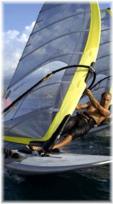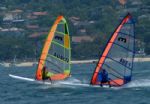Boardsailing - An Olympic Class History
by Bruce Kendall of New Zealand: (dual Olympian Medal winner)
Our sport is still called Boardsailing in Olympic jargon and was a demonstration sport at the 1984 Games in Los Angeles and an Olympic event at each Games since.
1984 - Los Angeles, USA
For Los Angeles, the Olympic board choice was between the original Windsurfer One Design manufactured by Hoyle Schwitzer and the Windglider designed and made in Europe. The Windglider was chosen late in 1983 based on it being more 'one design' as the Windsurfer was made of polyethylene and its rocker could be easily changed with heat and weight on a daily basis. The Windglider used a 6.5m sail but the use of a harness was not permitted. The daggerboard weighed around 4kgs and was carried over the sailor's shoulder during the downwind legs and when reaching with many sailors ending up with badly bruised thighs and legs from it swinging wildly and uncontrollably around in heavy weather. The course of 9 nautical miles sorted out who had put the time into training and who hadn't. A real Olympic feat just to finish. The supplied equipment was rotated daily (except for the rigs). The 1984 Olympic Games in Los Angeles were won by Stephan Vandenburg from Holland, Scott Steel from the USA was second and Bruce Kendall from New Zealand third. Bruce is still the youngest Olympic boardsailing medallist so far at 20 years of age. Australia's own Greg Hyde was there as well.
1988 - Pusan, Korea
The next Olympiad saw the introduction of Division II boards for the Olympics. The Division II class used a 6.5m sail and were round bottomed boards designed for upwind sailing in light to moderate winds and had a good competitive weight range. Although they were difficult to sail downwind and a technical board to sail upwind, they are still the fastest 12 foot board upwind in up to 8 knots of breeze. Again, the Olympic board was decided only one year before the Olympics. The contest had been between the Davidson (a Swedish design) and the Lechner built in Austria. The reason for the choice was a mystery to most but it was hinted that North Sails had some influence in the Lechner finally being selected. The final Olympic rig was available less than a year before the Olympics. Pusan in Korea was reportedly a light wind venue but no one realised until too late that this information came from the airport which was located in a sheltered valley. It turned out to be that the 1988 Olympic Games were the windiest ever with one day of racing postponed due to too much wind. one day of racing saw around 30 knots of wind with 5 knots of current going against the wind. There was a lot of equipment damage and rescues for many classes resulting in many DNF's and requests for redress. Again, the supplied equipment was rotated daily (except for the rigs). Bruce Kendall won Gold without having to sail in the last race, Jan Boresma from the Netherland Antilles (a surprise) won Silver while Mike Gebhart from the USA won the Bronze. Australia's Chris Lawrence was there as well.
1992 - Barcelona, Spain
For the 1992 Olympics, the Olympic Class for the first time was announced four years in advance and it was to include a women's event for the first time. This saw a real growth in Olympic windsurfing globally. the Lechner was modified to bring the centreboard and mast track further aft. The sail size went up to a camber induced 7.3m rig. this shifted the competitive weight range up without increasing it dramatically. The rig supplier, Neil Pryde, was decided 3 years before the Olympics. Barcelona was the first and only time (so far) that the Olympic village was next to the Olympic Harbour. Many there will remember having to sail in the polluted water. The supplied equipment stayed with the sailor for the entire regatta as it was excepted that each board needed special tuning to the daggerboard system. Barbara Kendall from New Zealand won Gold, Zhang Xiaodong from China won Silver with Doreen De Vries from Holland winning the Bronze. The men's regatta saw a close battle for the Gold between frank David from France, who eventually won and Mike Gebhart from the USA who won the Silver. Australia's Lars Kleppich won the Bronze. Fiona Taylor represented Australia in the women's event. There were some equipment failures that affected the medal results in this Olympics but for the first and last time there wasn't any redress allowed for equipment failure. This may have been a factor for the change from Division II to the Mistral Class for the next Olympics.
1996 - Atlanta, USA
The 1996 Atlanta Olympics were sailed in Savannah on the Warsaw Sound. For the most part the class and equipment to be used had been known since 1992. This gave the Olympic windsurfing sport a huge boost and helped make it more universal. For the first time amid much controversy pumping the sail was allowed. This had a dynamic effect on the sport and as in 1984, supreme fitness was a factor in deciding the Olympic winner. There was a surprisingly large amount of equipment failure in 1993 leading up to the Olympics such that some sailors would sail with an extra daggerboard. Some were able to break the boom at will. Mistral did its best to remedy this with some modifications. again, the supplied equipment stayed with the sailor for the entire regatta. There wasn't any significant equipment failure that effected medal chances. Sailors had to contend themselves with the one hour plus bus and boat ride from their accommodation to the floating barge where the equipment was stored and back each day. Most noteworthy were the regular and extreme thunder and lightning storms which resulted in postponed and abandoned races due to massive wind strength and direction changes. The Medallists came from all corners of the world which showed that finally the Olympic Boardsailing class was no longer dominated by the developed sailing nations. Lai Shan Lee from Hong Kong won the women's Gold, Barbara Kendall from New Zealand Silver and Alissandra Sensini from Italy the Bronze. Nikos Kalaminakis from Greece won the men's Gold, Carlos Espinola from Argentina the Silver and Gal Friedman from Israel won the Bronze. Brandan Todd who is currently Australia's Boardsailing Coach represented Australia in the men's event and Natasha Sturges representing in the women's event.
2000 - Sydney, Australia
There wasn't any significant challenge for equipment to
be used in the Boardsailing events for the 2000 Olympics in Sydney and
the Mistral One Design Class remained. This gave the class the chance to
consolidate itself worldwide and the Olympic aspirants a renewed
confidence in their preparations and campaigns for the 2000 Games. There
are now more Olympic Class Windsurfing Organisations around the world
and more Olympic Class boards on the water than ever before. The
international standard has a broader base than ever before. a look at
the last four years of World Championships results confirms this. The
Mistral One design is the most 'one design' of any of the Olympic
sailing classes and the least expensive to campaign. However, in 1997,
Mistral with only good intentions embarked on a mission to modify the
Olympic equipment to make it more durable, more 'one design' and more
user friendly without increasing costs or changing the performance
characteristics. This has been largely achieved. In an effort to further
reduce costs, Mistral tried to shift production of the boards to
Malaysia and then, due to perceived insurmountable difficulties, shifted
the production back to Europe. As often has been the case during
previous Olympiads, the supply of Olympic equipment didn't always meet
demand and this has caused much frustration for the sailors and has
prompted some call for a change. If there is a change of the Olympic
Class we will possibly be witnessing on Sydney Harbour for the last time
the pinnacle of Olympic Class Boardsailing in its purest form. If there
isn't a change, the Olympic Class stands to only get stronger and help
to build the whole sport of Windsurfing globally better than ever
before.
Due to the big equipment performance differences found in
other windsurfing classes Olympic Class Boardsailing is possibly the
most pure type of athletic sail racing in the world - a real Olympic
sport. Sadly, it is and possibly always will be little understood. Like
all small craft sailing classes, the best informed spectators are the
competitors. It has taken twenty years of two steps forward and one back
for Olympic Boardsailing to get to the level it is now. As a consequence
of the Olympic Boardsailing Class's current achievements, governments
are allocating a lot of funding towards growing the sport. The current
Olympic Class is a great asset to the sport of windsurfing. Let's look
after it and keep the current Olympic Class for at least another
Olympiad.
- this article first appeared in "On the Wind" Sep 2000. "On the Wind"
is a newsletter put out by the Stormriders Sailboard Club and the NSW
Boardsailing Association.




